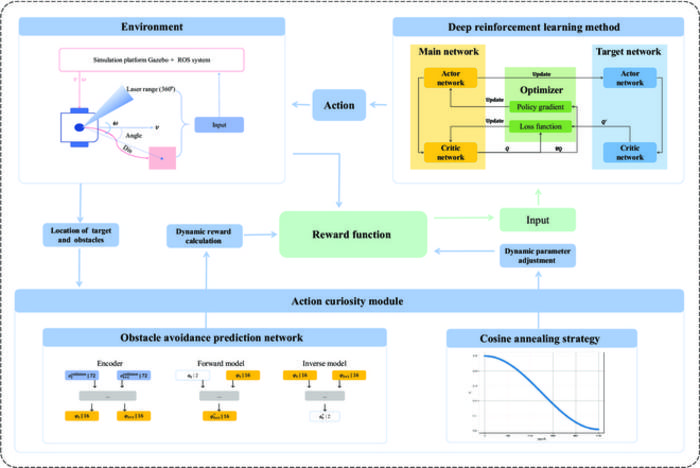Chinese Researchers Invent Novel Action Curiosity Algorithm to Enhance Autonomous Navigation in Uncertain Environments
According to foreign media reports, in a breakthrough in the field of autonomous navigation, a research team from Zhengzhou University has discovered a novel path planning optimization method that demonstrates excellent robustness in uncertain environments. The research paper titled "Action-Curiosity-Based Deep Reinforcement Learning Algorithm for Path Planning in a Nondeterministic Environment" was published on June 3rd, representing a significant leap in the integration of artificial intelligence with practical applications, especially focusing on autonomous vehicles.

Image source: Junxiao Xue et al.
The process of optimizing autonomous vehicle path planning is full of challenges, especially when these vehicles must cope with unpredictable traffic conditions. With the advancement of artificial intelligence technology, researchers are actively exploring various strategies to improve the efficiency and reliability of these systems. The newly developed optimization framework consists of three key components: an environment module, a deep reinforcement learning module, and an innovative action curiosity module.
The team equipped a TurtleBot3 Waffle robot with a precise 360-degree LiDAR sensor and placed it in a realistic simulation platform, testing their approach in four different scenarios. These tests ranged from simple static obstacle courses to extremely complex situations characterized by dynamic and unpredictable moving obstacles. Impressively, their method demonstrated significant improvements compared to several state-of-the-art baseline algorithms. Key performance metrics indicated notable enhancements in convergence speed, training duration, path planning success rate, and the average reward obtained by the agent.
The core of this method is the principle of deep reinforcement learning, a paradigm that enables agents to learn optimal behaviors through real-time interaction with dynamic environments. However, traditional reinforcement learning techniques often face obstacles such as slow convergence rates and suboptimal learning efficiency. To overcome these drawbacks, the team introduced an action curiosity module designed to enhance the agents' learning efficiency and encourage them to explore the environment to satisfy their innate curiosity.
This innovative curiosity module brings a paradigm shift to the agent's learning dynamics. It motivates the agent to focus on states of moderate difficulty, thereby maintaining a delicate balance between exploring novel states and exploiting behaviors with existing rewards. The action curiosity module extends previous intrinsic curiosity models by integrating an obstacle-aware prediction network. This network dynamically calculates curiosity rewards based on prediction errors related to obstacles, effectively guiding the agent to focus on states that can simultaneously optimize learning and exploration efficiency.
Crucially, the team also recognized that excessive exploration in the later stages of training could lead to performance degradation. To address this risk, they adopted a cosine annealing strategy, which is a technique for systematically adjusting the curiosity reward weight over time. This gradual adjustment is essential, as it stabilizes the training process and promotes more reliable convergence of the agent’s learned policies.
With the continuous advancement of autonomous navigation dynamics, this research paves the way for future improvements in path planning strategies. The team envisions integrating advanced motion prediction technologies, which will significantly enhance their method’s adaptability to highly dynamic and stochastic environments. These advancements are expected to bridge the gap between experimental success and real-world application, ultimately contributing to the development of safer and more reliable autonomous driving systems.
The significance of this research goes far beyond the scope of academic study. With the advancement of autonomous driving technology, enhanced path planning algorithms will play a key role in ensuring the safety and efficiency of autonomous vehicles operating under real-world conditions. By leveraging complex reinforcement learning strategies and adhering to a curiosity-driven approach, researchers are not only addressing existing challenges but also contributing to a broader discussion on the application of artificial intelligence and machine learning in the field of transportation.
In summary, deep reinforcement learning algorithms based on action curiosity represent a key innovation in the field of autonomous navigation. By addressing the complexities of stochastic environments, this approach holds the potential to revolutionize the way autonomous vehicles operate in unpredictable settings. As researchers continue to refine these algorithms and explore their applications, the future prospects of autonomous driving technology are becoming increasingly promising, laying the foundation for a new era of intelligent transportation systems.
The research community remains optimistic about the potential applications of this optimization method, which may lay the foundation for the development of future autonomous systems. With ongoing research and collaboration, the journey toward fully autonomous vehicles capable of safe and efficient navigation in complex environments is drawing closer, ultimately ushering in a future where technology and transportation coexist harmoniously.
【Copyright and Disclaimer】The above information is collected and organized by PlastMatch. The copyright belongs to the original author. This article is reprinted for the purpose of providing more information, and it does not imply that PlastMatch endorses the views expressed in the article or guarantees its accuracy. If there are any errors in the source attribution or if your legitimate rights have been infringed, please contact us, and we will promptly correct or remove the content. If other media, websites, or individuals use the aforementioned content, they must clearly indicate the original source and origin of the work and assume legal responsibility on their own.
Most Popular
-

List Released! Mexico Announces 50% Tariff On 1,371 China Product Categories
-

EU Changes ELV Regulation Again: Recycled Plastic Content Dispute and Exclusion of Bio-Based Plastics
-

Mexico officially imposes tariffs on 1,400 chinese products, with rates up to 50%
-

Clariant Unveils Cost-Cutting Plan Details, Plans to Shut Down Multiple Plants
-

Nissan Cuts Production of New Leaf EV in Half Due to Battery Shortage






